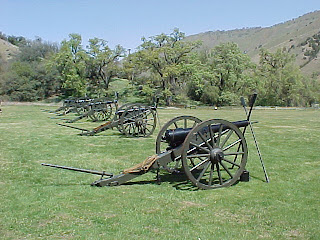Fort Tejon is located in the Grapevine Canyon, the main route between California's great central valley and Southern California. The fort was established to protect and control the Indians who were living on the Sebastian Indians Reservation, and to protect both the Indians and white settlers from raids by the wide-ranging and rather warlike Paiutes, Chemeheui, Mojave, and other Indian groups of the desert regions to the southeast. Fort Tejon was first garrisoned by the United States Army on August 10, 1854 and was abandoned ten years later on September 11, 1864.
The Native Americans who lived in this area prior to the establishment of Fort Tejon are generally referred to as the Emigdiano. They were an inland group of the Chumash people who lived along the Santa Barbara channel coastline. Unlike their coastal relatives, however, the Emigdiano avoided contact with European explorers and settlers, and were never brought into one of the missions or even incorporated into the Sebastian Indian Reservation. One of their villages was located at Tecuya Creek, north of Castaic Lake. Another village, Sasau, was on the north shore of the lake, while a third and still larger village, Lapau, was located at the bottom of Grapevine Canyon. Once Fort Tejon was established, the Emigdiano often worked as independent contractors for the army, providing guides for bear hunts and delivering fresh fruits from their fields for sale in officers row.
In 1852, President Millard Fillmore appointed Edward F. Beal to the position of Superintendent of Indian Affairs for California and Nevada, and sent him to California to head off further confrontation between the Indians and the many gold seekers and other settlers who were the pouring into California. After studying the situation, Beale decided that the best approach was to set up a large Indian reservation at the southern end of the San Joaquin Valley and to invite displaced Indian groups to settle there.
In order to implement his plan, Beale requested a federal appropriation of $500,000 and military support for the 75,000 acre reservation he had selected at the foot of Tejon Pass. Colonel Ethan Allen Hitchcock, commander of the Pacific Division of the U.S. Army, supported Beale's plan and agreed to set up a military post on or near the Indian reservation. The army was eager, in any case, to abandon Fort Miller (near Fresno) in favor of a more strategically advantageous site in the southern San Joaquin Valley.
In August 1854, Major J.L. Donaldson, a quartermaster officer, chose the present site in Canada de las Uvas. The site was handsome and promised adequate wood and water, It was just 17 miles southwest of the Sebastian Indian Reservation, and it was right on what Major Donaldson was convinced would become the main route between the central valley and Southern California.
The Fort Tejon earthquake occurred at about 8:20 AM (Pacific time) on January 9, 1857. It ruptured the San Andreas Fault for a length of about 350 kilometers (225 miles), between Parkfield and San Bernardino. Displacement along the fault was as much as 9 meters (30 feet) in the Carrizo Plain but less along the Palmdale section of the fault, closest to Los Angeles. The amount of fault slip gives this earthquake a moment magnitude of 7.9, comparable to that of the 1906 San Francisco earthquake. Based on the (uncertain) distribution of foreshocks for this earthquake, it is assumed that the beginning of the fault rupture (the epicenter) was in the area between Parkfield and Cholame, about 60 miles northwest. Nevertheless, it is usually called the "Fort Tejon" earthquake because this was the location of the greatest damage, most of the area being unpopulated at the time.
Only two fatalities were recorded as a result of this earthquake, one was a woman who was killed by a collapsing adobe house at Reed's Ranch (Gorman), very close to the fault. Most of the buildings at Fort Tejon were badly damaged and several people were injured. Some buildings in Los Angeles were cracked but no major damage was reported. In Ventura the roof of Mission San Buenaventura fell in and the bell tower collapsed. Ground cracks from liquefaction of swampy ground were observed in Los Angeles and near Oxnard. The earthquake was felt as far south as the mouth of the Colorado River, as far north as Marysville and as far east as Las Vegas.

Historic Marker at Ft. Tejon

Civil War reenactment (Confederate Army)



No comments:
Post a Comment
I appreciate your comments. Thanks for stopping by.
Kay